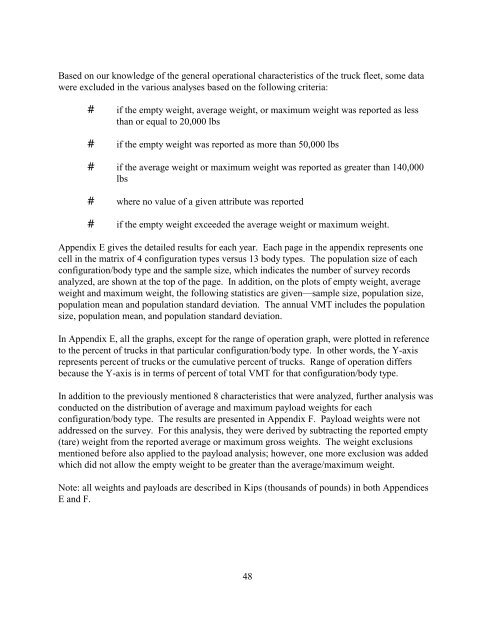Analysis of the Vehicle Inventory and Use Survey for Trucks ... - About
Analysis of the Vehicle Inventory and Use Survey for Trucks ... - About
Analysis of the Vehicle Inventory and Use Survey for Trucks ... - About
You also want an ePaper? Increase the reach of your titles
YUMPU automatically turns print PDFs into web optimized ePapers that Google loves.
Based on our knowledge <strong>of</strong> <strong>the</strong> general operational characteristics <strong>of</strong> <strong>the</strong> truck fleet, some data<br />
were excluded in <strong>the</strong> various analyses based on <strong>the</strong> following criteria:<br />
# if <strong>the</strong> empty weight, average weight, or maximum weight was reported as less<br />
than or equal to 20,000 lbs<br />
# if <strong>the</strong> empty weight was reported as more than 50,000 lbs<br />
# if <strong>the</strong> average weight or maximum weight was reported as greater than 140,000<br />
lbs<br />
# where no value <strong>of</strong> a given attribute was reported<br />
# if <strong>the</strong> empty weight exceeded <strong>the</strong> average weight or maximum weight.<br />
Appendix E gives <strong>the</strong> detailed results <strong>for</strong> each year. Each page in <strong>the</strong> appendix represents one<br />
cell in <strong>the</strong> matrix <strong>of</strong> 4 configuration types versus 13 body types. The population size <strong>of</strong> each<br />
configuration/body type <strong>and</strong> <strong>the</strong> sample size, which indicates <strong>the</strong> number <strong>of</strong> survey records<br />
analyzed, are shown at <strong>the</strong> top <strong>of</strong> <strong>the</strong> page. In addition, on <strong>the</strong> plots <strong>of</strong> empty weight, average<br />
weight <strong>and</strong> maximum weight, <strong>the</strong> following statistics are given—sample size, population size,<br />
population mean <strong>and</strong> population st<strong>and</strong>ard deviation. The annual VMT includes <strong>the</strong> population<br />
size, population mean, <strong>and</strong> population st<strong>and</strong>ard deviation.<br />
In Appendix E, all <strong>the</strong> graphs, except <strong>for</strong> <strong>the</strong> range <strong>of</strong> operation graph, were plotted in reference<br />
to <strong>the</strong> percent <strong>of</strong> trucks in that particular configuration/body type. In o<strong>the</strong>r words, <strong>the</strong> Y-axis<br />
represents percent <strong>of</strong> trucks or <strong>the</strong> cumulative percent <strong>of</strong> trucks. Range <strong>of</strong> operation differs<br />
because <strong>the</strong> Y-axis is in terms <strong>of</strong> percent <strong>of</strong> total VMT <strong>for</strong> that configuration/body type.<br />
In addition to <strong>the</strong> previously mentioned 8 characteristics that were analyzed, fur<strong>the</strong>r analysis was<br />
conducted on <strong>the</strong> distribution <strong>of</strong> average <strong>and</strong> maximum payload weights <strong>for</strong> each<br />
configuration/body type. The results are presented in Appendix F. Payload weights were not<br />
addressed on <strong>the</strong> survey. For this analysis, <strong>the</strong>y were derived by subtracting <strong>the</strong> reported empty<br />
(tare) weight from <strong>the</strong> reported average or maximum gross weights. The weight exclusions<br />
mentioned be<strong>for</strong>e also applied to <strong>the</strong> payload analysis; however, one more exclusion was added<br />
which did not allow <strong>the</strong> empty weight to be greater than <strong>the</strong> average/maximum weight.<br />
Note: all weights <strong>and</strong> payloads are described in Kips (thous<strong>and</strong>s <strong>of</strong> pounds) in both Appendices<br />
E <strong>and</strong> F.<br />
48

















